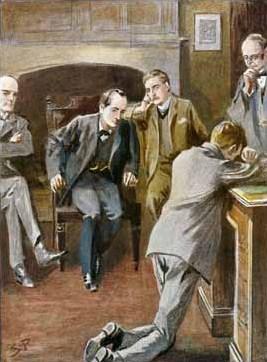“The Adventure of the Three Students”, Sir Arthur Conan Doyle’s 37th Sherlock Holmes short story, was first published in The Strand MagazineMonthly publication founded by George Newnes, published 1891–1950, credited with introducing the short story to a British audience. in the United Kingdom in June 1904, followed by Collier’s in the United States on 24 September 1904.[1] It was subsequently included in The Return of Sherlock Holmes, a collection of 13 short stories published in the US in February 1905 and in the UK in March 1905.[2]
The story, set in 1895, concerns the illicit copying of an exam paper by one of three students applying for a substantial scholarship at an English university.
Synopsis
Holmes and Watson are spending some time in one of England’s “great university towns” when they receive a visit from Hilton Soames, a tutor at St Luke’s College. He had left the proofs of an examination paper on his desk while he went to have tea with a friend, and upon his return noticed that there was a key in the door, carelessly left there by his servant, Bannister.

Wikimedia Commons
On entering his room he noticed that his papers had been disturbed, and on the table by the window he found a broken pencil lead and some shavings, leading him to believe that someone had been hurriedly copying the papers and broken the tip of his pencil. He also found a fresh cut in the surface of his desk, and a small blob of black clay speckled with sawdust.
The three students about to take the exam live above Soames, in the same building. The first, Gilchrist, is athletic, a hurdler, long-jumper, and industrious son of the notorious Sir Jabez Gilchrist, who ruined himself gambling; the second, Daulat Ras, is quiet and methodical; the third is Miles McLaren, bright but lazy and unprincipled.
Holmes examines the office, concluding that the cheat took the papers over to the window one by one while he copied them so that he could see Soames returning, but Soames did not come back his usual way. A nearby door leads to Soames’s bedroom. Upon examining that, Holmes finds another, similar, sawdust-speckled blob of clay. He stuns Soames by telling him that the cheat, upon hearing his approach, hid in Soames’s bedroom, and was hiding behind a curtain while Soames was questioning Bannister.
The next morning, Holmes and Watson return to Soames’s office. Holmes confronts Bannister, accusing him of withholding information. Bannister insists that there was no one in Soames’s office while he was there. Holmes sends for Gilchrist, and proceeds to lay out his evidence.
The cheat was someone who knew the exam proofs were there. This could only be Gilchrist, because the whereabouts of the proofs had been kept secret, and Gilchrist was the only one of the three students tall enough to look in through Soames’s window to see his desk. Holmes also identified the blobs as the special clay found in the long-jump pit. Gilchrist reproaches Bannister, who had been his father’s butler, for his apparent treachery.
Holmes goes on to explain the remaining clues. The scratch on the desk was caused by Gilchrist’s spiked jumping shoes as he grabbed them in his haste, and the clay blobs fell from his shoes. For his part, Gilchrist credits Bannister with convincing him not to profit from his misdeed, and presents Soames with a letter stating his wish not to sit the exam, but instead to accept an offer to work for the Rhodesian Police.
Adaptations
A silent short film adapted from the story was released in 1923 as part of the Stoll film series starring Eille Norwood as Sherlock Holmes and Hubert Willis as Watson, with William Lugg as Hilton Soames and A. Harding Steerman as Bannister.[3]
